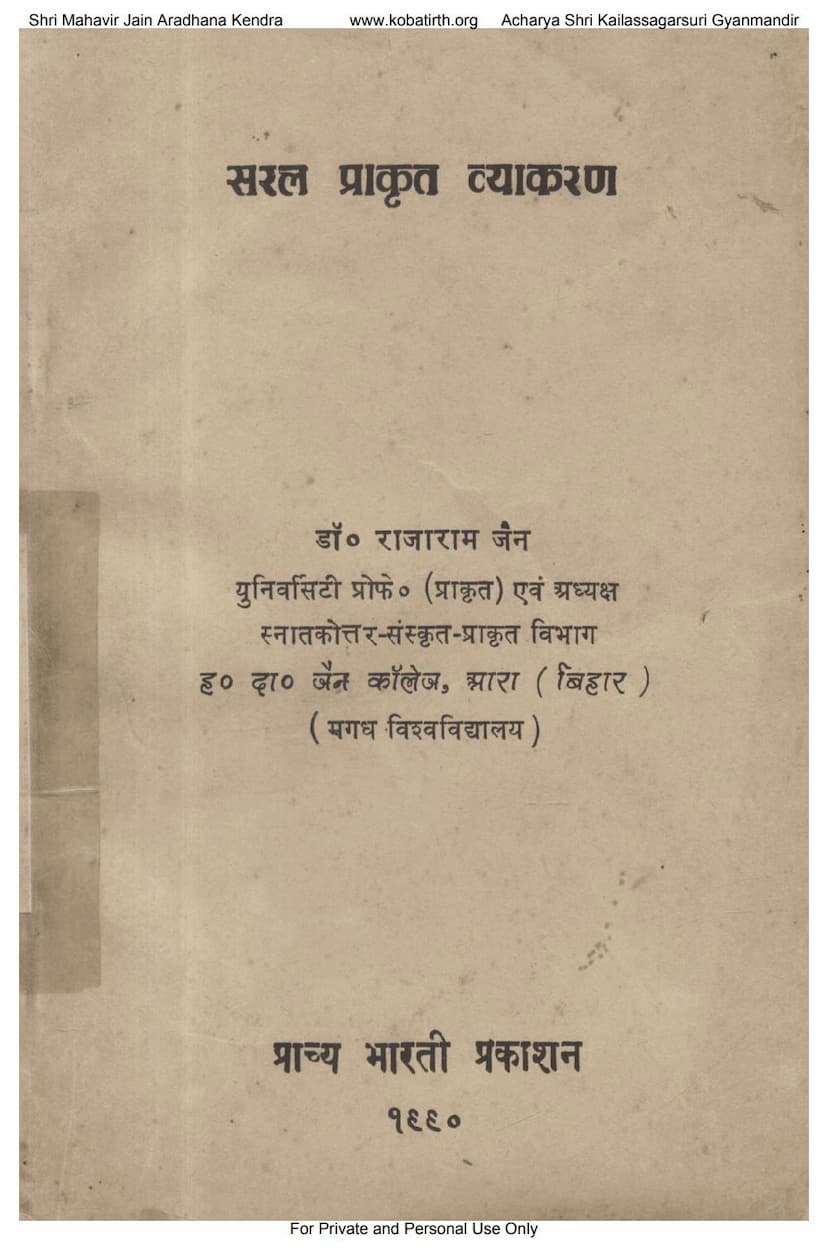Saral Prakrit Vyakaran
Added to library: September 2, 2025

Summary
This document is a summary of the Jain text "Saral Prakrit Vyakaran" (Simple Prakrit Grammar) by Rajaram Jain, published by Prachya Bharati Prakashan in 1960.
The book is a comprehensive guide to the Prakrit language, aiming to simplify its study for beginners. The preface highlights the historical significance of Prakrit as a vernacular language used by prominent figures like Mahavir, Buddha, and Emperor Ashoka, and its integration into Sanskrit dramas. It also acknowledges the existence of numerous ancient Prakrit grammar texts, most of which are now unavailable, and lists the prominent available ones, including those by Hemachandra, Vararuchi, and others, noting their acceptance in universities worldwide.
The author explains that Prakrit is considered the natural, everyday language of the people, distinct from Sanskrit, which was codified by grammar. The book aims to fill the gap for students and general readers who found existing Prakrit grammars too complex and expensive.
The book is structured into several lessons:
- Lesson One: Alphabet (Varnamala): Covers vowels and consonants, noting specific Prakrit rules like the absence of certain Sanskrit vowels and the use of 's' for 'sh' and 'ṣh' in most Prakrit forms.
- Lesson Two: General Rules of Prakrit Language (Dhvani Parivartan): Discusses sound changes, specifically vowel and consonant transformations, providing examples of how Sanskrit words are adapted into Prakrit. This includes vowel elision, lengthening/shortening, and consonant changes like 'n' to 'ṇ', 'y' to 'j', and 'sh/ṣh' to 's'. It also details rules for the elision of certain consonants and their transformation into 'h'.
- Lesson Three: Sandhis (Phonetic Combinations): Defines sandhi and samyoga, explaining that sandhi in Prakrit is often optional. It categorizes sandhis into vowel sandhi, consonant sandhi, and indeclinable sandhi, detailing rules for vowel combinations like long vowel sandhi and guna sandhi, as well as natural sandhi (Prakriti Bhava) where sandhi is avoided.
- Fourth Lesson: Kridant (Verbal Derivatives): Explains the formation of verbal derivatives (kridantas) used to create nouns and adjectives from verbs. It covers present tense kridantas, past tense kridantas, future tense kridantas, and various other types like those indicating purpose, obligation, and habitual action, providing extensive examples.
- Fifth Lesson: Taddhita (Nominal Derivatives): Covers the formation of words from nouns and adjectives using taddhita suffixes to express specific meanings, such as offspring, comparative degrees, possession, abstract qualities, and more, with numerous examples.
- Sixth Lesson: Feminine Suffixes (Stri Pratyaya): Explains how to form feminine words from masculine ones using suffixes like 'ā', 'ī', and 'ū', and discusses various rules and exceptions for these transformations, including the formation of words denoting female teachers and specific relationships.
- Seventh Lesson: Karaka and Vibhakti (Cases and Terminations): Defines karaka (agent or role in an action) and vibhakti (grammatical case ending). It highlights the difference between karakas and vibhaktis and notes that Prakrit has six cases, with the fourth and sixth being identical. It details the usage of case endings and provides examples, noting some variations from Sanskrit.
- Eighth Lesson: Samasa (Compounding): Defines samasa as the process of combining words concisely while retaining meaning. It explains the difference between samasa and vigraha (analysis of a compound). The lesson categorizes samasas into Avyayibhava, Tatpurusha, Bahuvrihi, and Dvandva, explaining their formation and providing examples for each, including sub-categories within Tatpurusha and Karmadharaya.
- Ninth Lesson: Shabd Rup (Word Forms/Declensions): Discusses the nature of words, differentiating between indeclinable (avyaya) and declinable words. It highlights key features of Prakrit word forms, such as the absence of the dual number, the identity of the fourth and sixth cases, and the non-existence of certain Sanskrit vowels. It then provides detailed declension paradigms for masculine nouns ending in 'a', 'i', 'u', and feminine nouns ending in 'a', 'i', 'ī', 'u', 'ū', and also covers pronouns like "aham" (I) and "tvam" (you), and numeral words.
- Tenth Lesson: Dhatu Rup (Verb Forms/Conjugations): Defines root words (dhatu) and verbs (kriya). It outlines the key characteristics of Prakrit verb forms, including the presence of only singular and plural, three persons, the use of the 'pra' augment for consonant-ending roots, the dominance of perispada (active voice) over atmanepada, and the common tenses (present, past, future) and moods (imperative, optative). It then provides conjugation paradigms for common verbs in various tenses and moods, illustrating the application of Prakrit grammatical rules.
The book concludes with verses emphasizing the importance and beauty of Prakrit language and poetry. It is presented as a tool to assist aspiring scholars in their journey to understand and appreciate Prakrit literature and grammar.